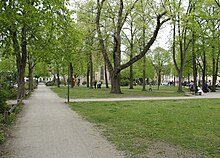Bohlenplatz
The Bohlenplatz is a place in the city of Erlangen . He is known for its greenery a short break in the city center as the venue of the best known and most traditional Erlanger flea market and because of the former German Reformed Church , now under the name Cross + Cross - House of the Church of Erlangen as a venue from the Evangelical Lutheran deanery Erlangen used becomes.
history
Originally, today's Bohlenplatz was simply referred to as the square near the German Reformed Church . In the 19th century, the name Poland Square was formed for this square and the adjacent, vacant building block to the east . In 1872 the name was changed to Bohlenplatz. The reference to the social milieu of the residents and their “Polish” disorder was thus reinterpreted as a building yard used by carpenters . From 1933 to 1945 the square was named after the anti-Semitic publicist and publisher Dietrich Eckart .
The originally poor, only single-storey houses of the hosiery and craftsmen were added or rebuilt over time. The space was also initially misused for debris deposits or as a sand pit . From 1780, however, attempts were made to counteract this by repeatedly planting trees , for example when mulberry trees were planted for silkworms in 1826 . It was not until 1887 that a uniform overall design took place for the first time, which roughly corresponded to the current character of the square. Bohlenplatz underwent the last major redesign in 1982.
In the course of history there have also been a number of never realized projects at Bohlenplatz: In 1836, it was planned to build the train station here. In 1910 it was proposed to create an outdoor swimming pool at Bohlenplatz . In addition, it was planned several times to at least partially build over the eastern half of the square, which only happened with the establishment of the new university building authority in 1970. Finally, at the time of National Socialism , a huge war memorial was planned, but it was never implemented. An artesian well , 222 meters deep and built between 1864 and 1869 at the southeast corner of Bohlenplatz, did not deliver the hoped for water and was therefore closed in 1945. In 1919 the city built one of the first two children's playgrounds in Erlangen on Bohlenplatz ; A children's playground can still be found at Bohlenplatz today.
description
Bohlenplatz is a 200-meter-long and 80-meter-wide square in a west-east direction in the historic old town of Erlangen. Although it was not created until later, it fits in perfectly with the pattern of Erlangen Neustadt as a planned baroque town . The extensive square is affected in the south by the Friedrichstrasse – Luitpoldstrasse street, in the north by the Obere Karlstrasse – Marquardsenstrasse street and in the east by the Ostliche Stadtmauerstrasse – Waldstrasse street. The Raumerstraße also goes south to the south. A sidewalk and bike path in the escape Krankenhausstraße – Holzgartenstraße separates the Bohlenplatz into two unequal parts. The western third is occupied by the former German Reformed Church. The eastern part is green and designed like a park . There is also a children's playground here . The eastern end of the square is marked by the new building of the university building authority from 1970.
Adjacent buildings

Former German Reformed Church
literature
- Christoph Friedrich, Bertold Freiherr von Haller, Andreas Jakob (Hrsg.): Erlanger Stadtlexikon . W. Tümmels Verlag, Nuremberg 2002, ISBN 3-921590-89-2 ( complete edition online ).
Web links
Individual evidence
Coordinates: 49 ° 35 ′ 48.2 " N , 11 ° 0 ′ 41.8" E
